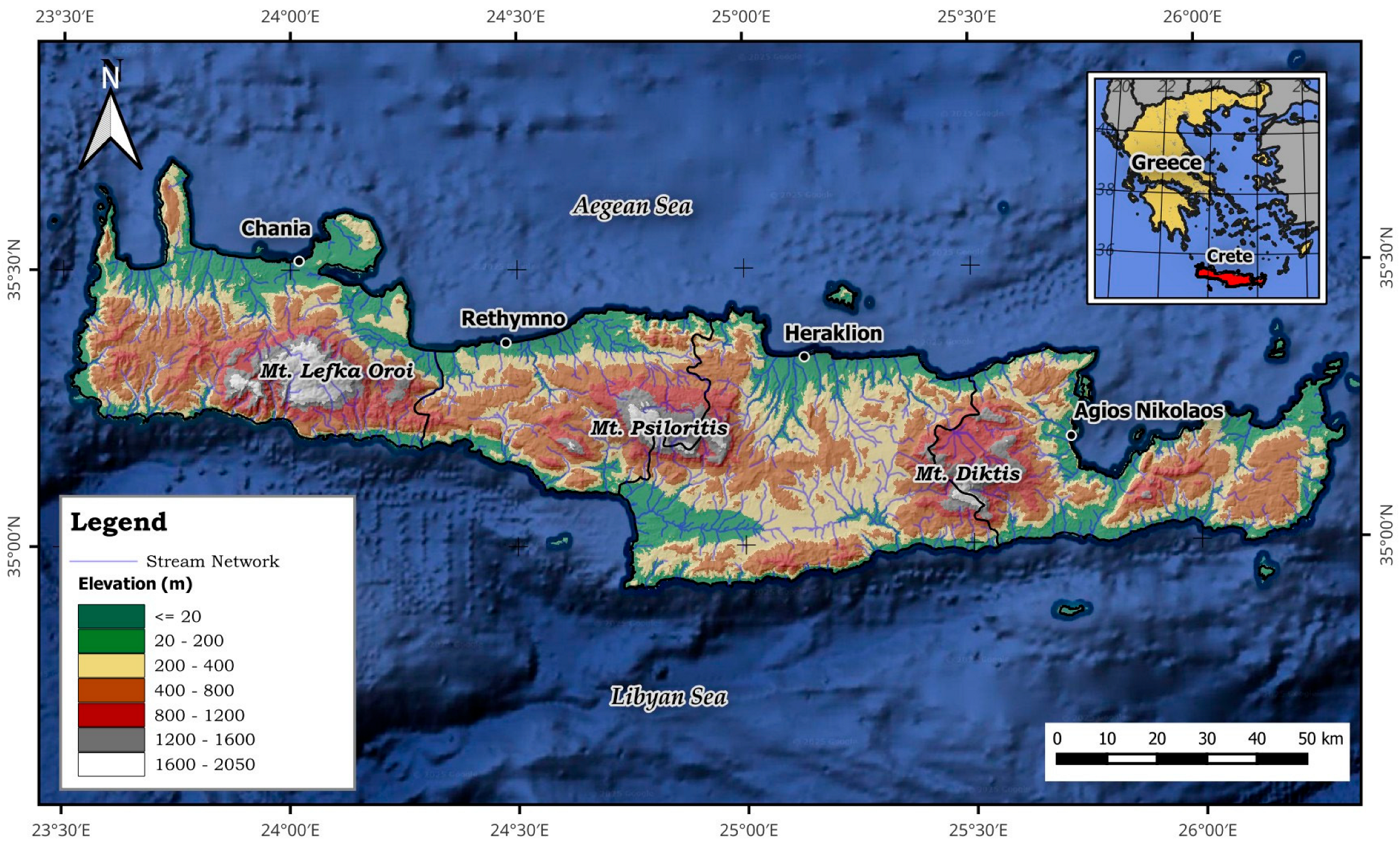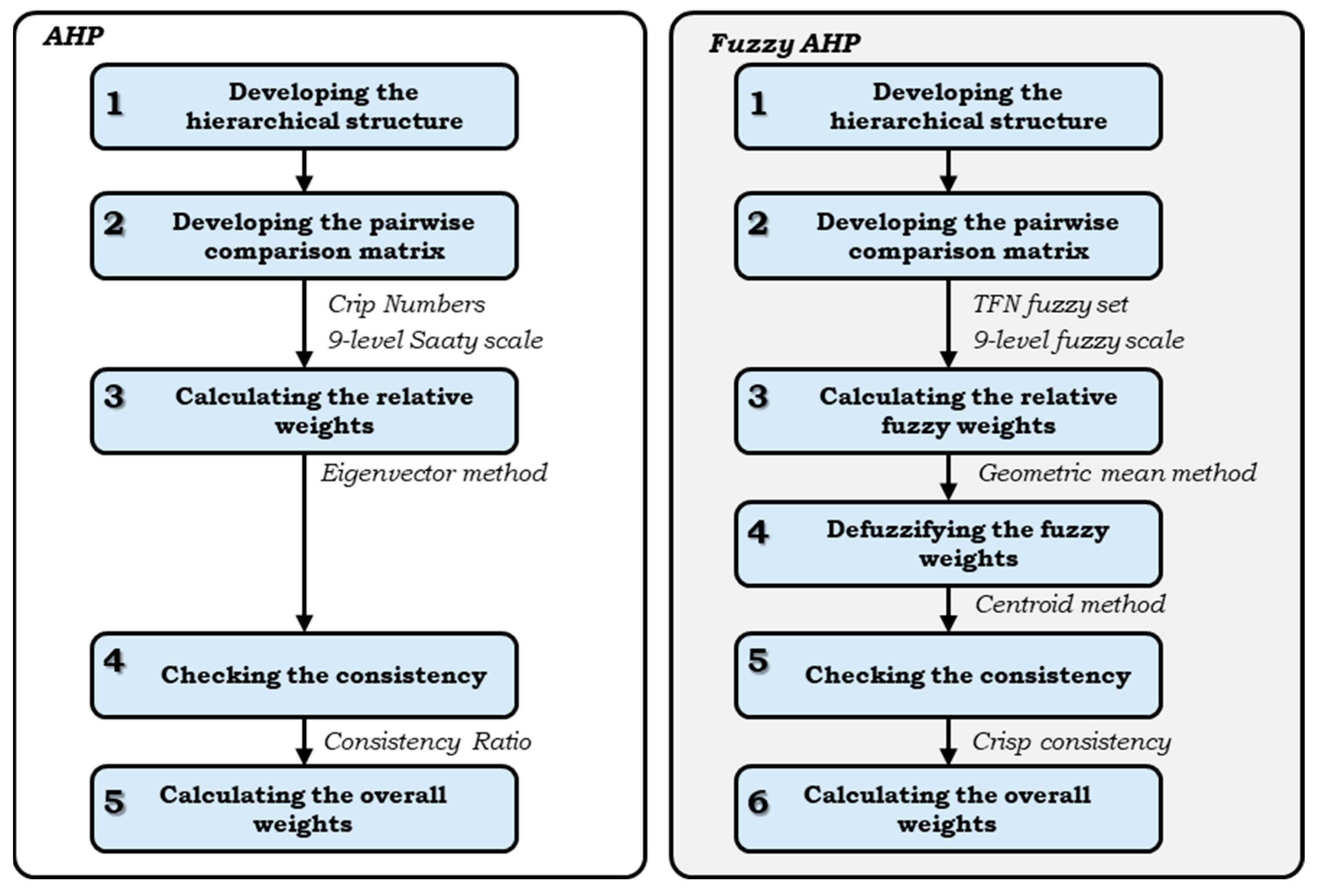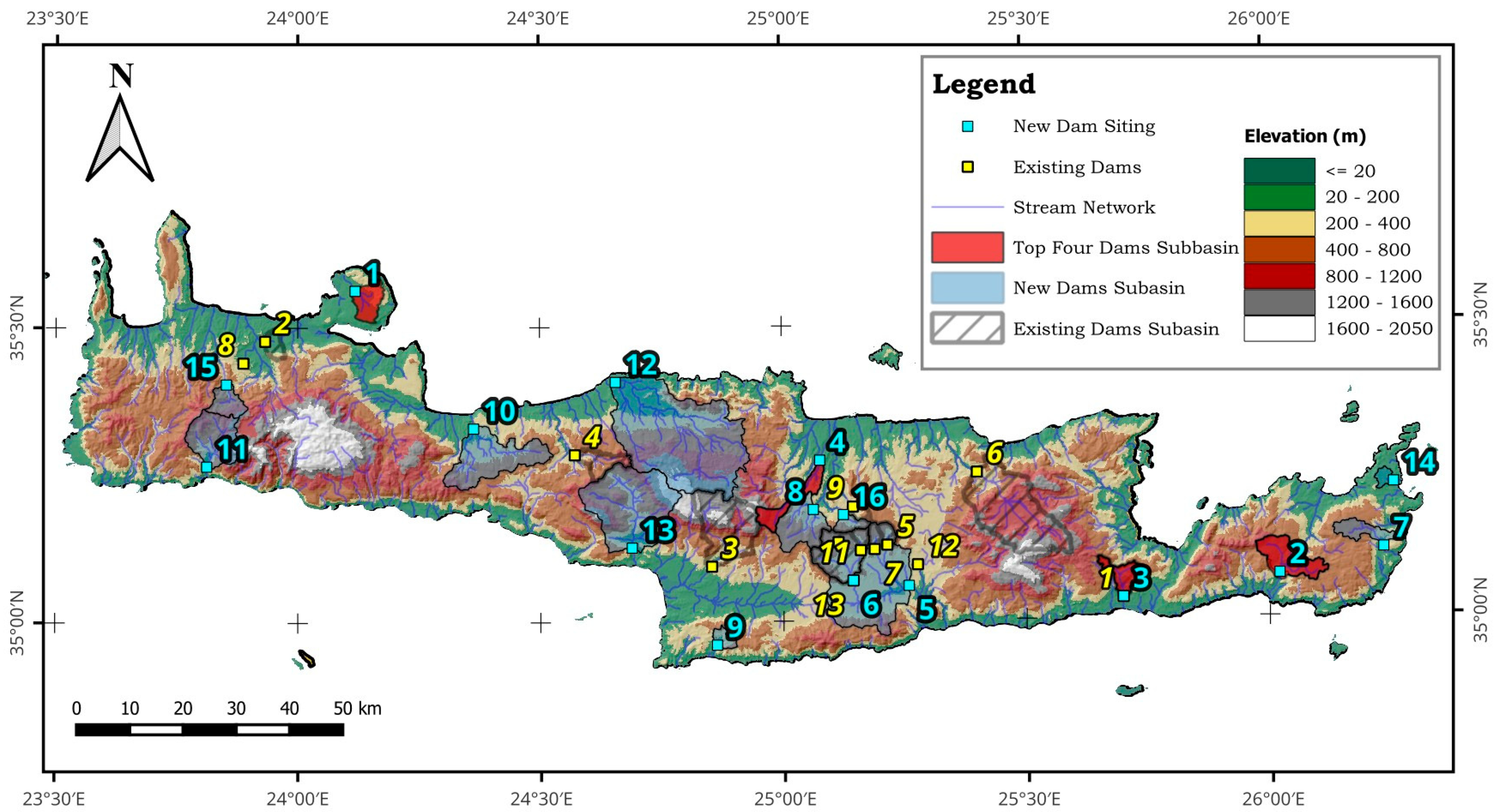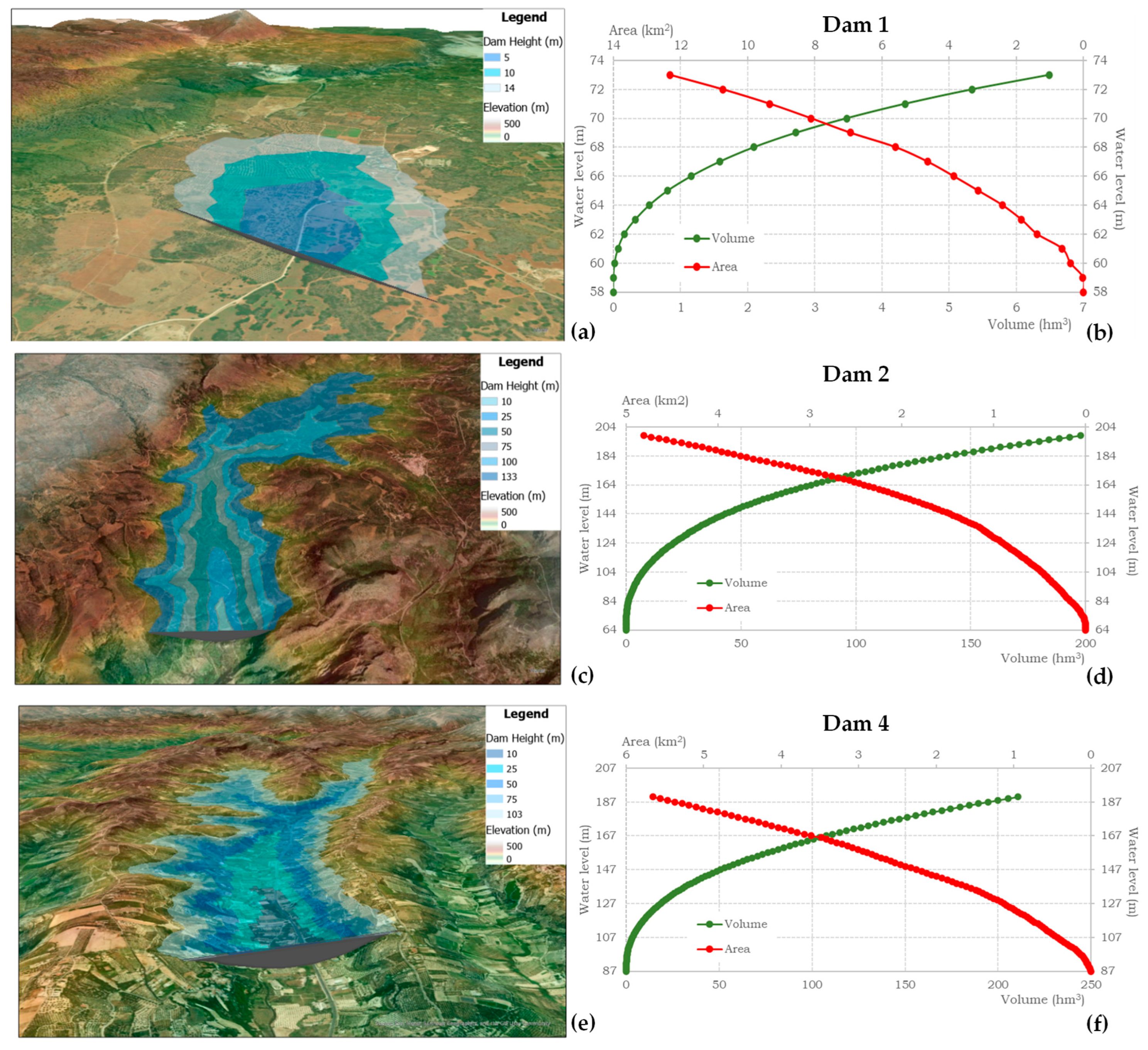Multi-Criteria Analysis for Optimal Siting of Reservoirs in Crete
Abstract
1. Introduction
2. Study Area
3. Materials and Methods
3.1. Study Framework
3.2. Data Site Criteria
Data Used
3.3. MCDM
3.3.1. AHP
3.3.2. FAHP
3.3.3. Reclassification
- The most suitable areas were open spaces with little or no vegetation, followed by shrub and herbaceous vegetation (moderately suitable), and finally forests (low suitability). This classification, which is well-established in the literature [3,4,13,20], is predicated on the principle that barren or sparsely vegetated land generates higher surface runoff due to lower infiltration, making it ideal for RWH [13].
3.4. Validation
3.5. Sensitivity Analysis
3.6. 3D Analysis
4. Results and Discussion
4.1. Suitability Maps
4.2. Validation Results
- Expert judgment
- Project-specific risk tolerance
- Geological conditions
4.3. Sensitivity Analysis Results
- The top four locations were present in all six sensitivity scenarios.
- Five out of the six scenarios produced only one new location, with the rest being shared with the original map.
4.4. Three-Dimensional Analysis of Proposed Sites
5. Conclusions
- The developed suitability maps demonstrate satisfactory predictive performance, validating their value as a preliminary screening tool, identifying potential dam sites across an extensive area. More favorable locations are prioritized and highly unsuitable areas are excluded, significantly reducing the resources needed for on-site investigations.
- The use of Fuzzy AHP didn’t provide any additional value when compared to the AHP method. Fuzzy AHP can handle uncertain or inconsistent input data, e.g., multiple divergent expert judgments [30]. However, for cases where pairwise comparisons can be defined with high certainty (crisp data), the additional computational complexity of the fuzzy extension may not be justified by a corresponding increase in result accuracy.
- The reliability of the results is intrinsically linked to the quality, resolution, and completeness of the underlying geospatial data, as well as to the subjective judgments of the decision-makers.
- The results should be interpreted as a tool to narrow down potential locations and should not be used for definitive judgements. Further geospatial analysis as well as on-site investigations should be carried out to identify suitable locations for dam siting.
- This study used stream order and a catchment area threshold as hydrological parameters and did not include rainfall/runoff measurements. This decision was based on the case-specific conditions and validation revealed satisfactory performance. However, for an in-depth evaluation of selected locations, a detailed hydrological analysis is needed. Additionally, when applying this methodology to other areas, these criteria may not suffice.
- Implementation of valley morphology assessment methods. Valley morphology plays a key role in dam feasibility, characteristics, and performance and should be included in site identification. However, implementing valley morphology in GIS tools remains challenging.
- Incorporation of more precise hydrologic indices (rainfall patterns, runoff volumes). While stream order serves as a water volume proxy, it is only an indirect indicator that stems solely from the geomorphological characteristics of the area. Although our comparison with rainfall data demonstrated its utility, a more comprehensive analysis evaluating stream order against direct actual runoff data could further quantify stream order’s reliability and refine its application as a proxy.
Author Contributions
Funding
Data Availability Statement
Conflicts of Interest
Abbreviations
| RS | Remote Sensing |
| GIS | Geographic Information Systems |
| MCDM | Mult-Criteria Decision-Making |
| AHP | Analytic Hierarchy Process |
| FAHP | Fuzzy Analytic Hierarchy Process |
| LULC | Land Use Land Cover |
| HSG | Hydrologic Soil Group |
| DEM | Digital Elevation Model |
| TPI | Topographic Position Index |
References
- Al-Ruzouq, R.; Shanableh, A.; Yilmaz, A.G.; Idris, A.; Mukherjee, S.; Khalil, M.A.; Gibril, M.B.A. Dam Site Suitability Mapping and Analysis Using an Integrated GIS and Machine Learning Approach. Water 2019, 11, 1880. [Google Scholar] [CrossRef]
- Noori, A.; Pradhan, B.; Ajaj, Q. Dam Site Suitability Assessment at the Greater Zab River in Northern Iraq Using Remote Sensing Data and GIS. J. Hydrol. 2019, 574, 964–979. [Google Scholar] [CrossRef]
- Shao, Z.; Jahangir, Z.; Muhammad Yasir, Q.; Atta-ur-Rahman; Mahmood, S. Identification of Potential Sites for a Multi-Purpose Dam Using a Dam Suitability Stream Model. Water 2020, 12, 3249. [Google Scholar] [CrossRef]
- Karimi, H.; Zeinivand, H. Integrating Runoff Map of a Spatially Distributed Model and Thematic Layers for Identifying Potential Rainwater Harvesting Suitability Sites Using GIS Techniques. Geocarto Int. 2019, 36, 320–339. [Google Scholar] [CrossRef]
- Luis, A.d.A.; Cabral, P. Small Dams/Reservoirs Site Location Analysis in a Semi-Arid Region of Mozambique. Int. Soil Water Conserv. Res. 2021, 9, 381–393. [Google Scholar] [CrossRef]
- Sayl, K.; Muhammad, N.S.; El-Shafie, A. Robust Approach for Optimal Positioning and Ranking Potential Rainwater Harvesting Structure (RWH): A Case Study of Iraq. Arab. J. Geosci. 2017, 10, 413. [Google Scholar] [CrossRef]
- Wang, Y.; Tian, Y.; Cao, Y. Dam Siting: A Review. Water 2021, 13, 2080. [Google Scholar] [CrossRef]
- Yadav, S.; Mohseni, U.; Vasave, M.D.; Thakur, A.S.; Tadvi, U.R.; Pawar, R.S. Assessing Dam Site Suitability Using an Integrated AHP and GIS Approach: A Case Study of the Purna Catchment in the Upper Tapi Basin, India. Environ. Earth Sci. Proc. 2025, 32, 21. [Google Scholar] [CrossRef]
- Gacko, I.; Muchová, Z.; Jurík, Ľ.; Šinka, K.; Fabian, L.; Petrovič, F. Decision Making Methods to Optimize New Dam Site Selections on the Nitra River. Water 2020, 12, 2042. [Google Scholar] [CrossRef]
- Majid, S.Z.; Saeed, M.; Ishtiaq, U.; Argyros, I.K. The Development of a Hybrid Model for Dam Site Selection Using a Fuzzy Hypersoft Set and a Plithogenic Multipolar Fuzzy Hypersoft Set. Foundations 2024, 4, 32–46. [Google Scholar] [CrossRef]
- Ibrahim, G.R.F.; Rasul, A.; Ali Hamid, A.; Ali, Z.F.; Dewana, A.A. Suitable Site Selection for Rainwater Harvesting and Storage Case Study Using Dohuk Governorate. Water 2019, 11, 864. [Google Scholar] [CrossRef]
- Ullah, S.; Iqbal, M.; Waseem, M.; Abbas, A.; Masood, M.; Nabi, G.; Tariq, M.A.U.R.; Sadam, M. Potential Sites for Rainwater Harvesting Focusing on the Sustainable Development Goals Using Remote Sensing and Geographical Information System. Sustainability 2024, 16, 9266. [Google Scholar] [CrossRef]
- Alrawi, I.; Jianping, C.; Othman, A.; Ali, S.; Harash, F. Insights of Dam Site Selection for Rainwater Harvesting Using GIS: A Case Study in the Al- Qalamoun Basin, Syria. Heliyon 2023, 9, 16. [Google Scholar] [CrossRef] [PubMed]
- Aghaloo, K.; Chiu, Y.-R. Identifying Optimal Sites for a Rainwater-Harvesting Agricultural Scheme in Iran Using the Best-Worst Method and Fuzzy Logic in a GIS-Based Decision Support System. Water 2020, 12, 1913. [Google Scholar] [CrossRef]
- Al-Kakey, O.; Othman, A.A.; Al-Mukhtar, M.; Dunger, V. Proposing Optimal Locations for Runoff Harvesting and Water Management Structures in the Hami Qeshan Watershed, Iraq. ISPRS Int. J. Geo-Inf. 2023, 12, 312. [Google Scholar] [CrossRef]
- Fernández-Enríquez, A.; Pérez-Cayeiro, M.L.; Anfuso, G. GIS Modeling to Climate Change Adaptation by Reducing Evaporation in Water Reservoirs: Smart Location Technique of Minimal Evaporation Reservoirs (GIS-MER). Sustainability 2022, 14, 13822. [Google Scholar] [CrossRef]
- Masood, M.U.; Khan, N.M.; Haider, S.; Anjum, M.N.; Chen, X.; Gulakhmadov, A.; Iqbal, M.; Ali, Z.; Liu, T. Appraisal of Land Cover and Climate Change Impacts on Water Resources: A Case Study of Mohmand Dam Catchment, Pakistan. Water 2023, 15, 1313. [Google Scholar] [CrossRef]
- Minatour, Y.; Khazaei, J.; Ataei, M. Earth Dam Site Selection Using the Analytic Hierarchy Process (AHP): A Case Study in the West of Iran. Arab. J. Geosci. 2012, 6, 3417–3426. [Google Scholar] [CrossRef]
- Dirie, A.; Jamei, M.; OleiwiSulaiman, S. A Comprehensive Review for the Dams Site Selection Based on Multi-Criteria: Assessment and Evaluation. AUIQ Tech. Eng. Sci. 2024, 1, 4. [Google Scholar] [CrossRef]
- Mbura, F. Site Selection for an Earth Dam in Mbeere North, Embu County—Kenya. J. Geosci. Environ. Prot. 2018, 06, 113–133. [Google Scholar] [CrossRef]
- Zytoon, A.; Gharineiat, Z.; Alajarmeh, O. Supplementary Dam Site Selection Using a Geospatial Approach: A Case Study of Wivenhoe Dam. ISPRS Int. J. Geo-Inf. 2024, 13, 180. [Google Scholar] [CrossRef]
- Rahmati, O.; Kalantari, Z.; Samadi, M.; Uuemaa, E.; Moghaddam, D.D.; Nalivan, O.A.; Destouni, G.; Tien Bui, D. GIS-Based Site Selection for Check Dams in Watersheds: Considering Geomorphometric and Topo-Hydrological Factors. Sustainability 2019, 11, 5639. [Google Scholar] [CrossRef]
- Minatour, Y.; Khazaei, J.; Ataei, M.; Javadi, A.A. An Integrated Decision Support System for Dam Site Selection. Sci. Iran. 2015, 22, 319–330. [Google Scholar]
- Liu, J.; Tan, J.; Zhang, S.; Zhong, C.; Lv, L.; Tara, A. Suitability Assessment of Small Dams’ Location as Nature-Based Solutions to Reduce Flood Risk in Mataniko Catchment, Honiara, Solomon Islands. Sustainability 2023, 15, 3313. [Google Scholar] [CrossRef]
- Teschemacher, S.; Bittner, D.; Disse, M. Automated Location Detection of Retention and Detention Basins for Water Management. Water 2020, 12, 1491. [Google Scholar] [CrossRef]
- Handhal, A. A GIS-Based Integrated Fuzzy Logic and Analytic Hierarchy Process Model for Assessing Water-Harvesting Zones in Northeastern Maysan Governorate, Iraq. Arab. J. Sci. Eng. 2017, 42, 2487–2499. [Google Scholar]
- Khan, D.; Raziq, A.; Young, H.-W.V.; Sardar, T.; Liou, Y.-A. Identifying Potential Sites for Rainwater Harvesting Structures in Ghazi Tehsil, Khyber Pakhtunkhwa, Pakistan, Using Geospatial Approach. Remote Sens. 2022, 14, 5008. [Google Scholar] [CrossRef]
- Odiji, C.; Adepoju, M.; Ibrahim, I.; Oluwatola, A.; Ihenacho, N.; Olaide, A. Small Hydropower Dam Site Suitability Modelling in Upper Benue River Watershed, Nigeria. Appl. Water Sci. 2021, 11, 1–17. [Google Scholar] [CrossRef]
- Saaty, T.L. A Scaling Method for Priorities in Hierarchical Structures. J. Math. Psychol. 1977, 15, 234–281. [Google Scholar] [CrossRef]
- Liu, Y.; Eckert, C.; Earl, C. A Review of Fuzzy AHP Methods for Decision-Making with Subjective Judgements. Expert Syst. Appl. 2020, 161, 113738. [Google Scholar] [CrossRef]
- Othman, A.A.; Al-Maamar, A.F.; Al-Manmi, D.A.M.A.; Liesenberg, V.; Hasan, S.E.; Obaid, A.K.; Al-Quraishi, A.M.F. GIS-Based Modeling for Selection of Dam Sites in the Kurdistan Region, Iraq. ISPRS Int. J. Geo-Inf. 2020, 9, 244. [Google Scholar] [CrossRef]
- Baltas, E.; Tzoraki, O. Water Resources Management on the Island of Crete: Lessons Learned. In Free Flow—Reaching Water Security Through Cooperation, Tudor Rose; United Nations International Year of Water Cooperation, UNESCO, Tudor Rose: Paris, France, 2013; pp. 285–289. ISBN 978-92-3-104256-0. [Google Scholar]
- Tzanakakis, V.A.; Angelakis, A.N.; Paranychianakis, N.V.; Dialynas, Y.G.; Tchobanoglous, G. Challenges and Opportunities for Sustainable Management of Water Resources in the Island of Crete, Greece. Water 2020, 12, 1538. [Google Scholar] [CrossRef]
- UNISEF Confronting a Changed Childhood in Crete. Available online: https://www.unicef.org/greece/en/confronting-changed-childhood-crete (accessed on 24 August 2025).
- Hellenic Statistical Authority 2021 Population-Housing Census. Available online: https://www.statistics.gr/en/2021-census-pop-hous (accessed on 24 August 2025).
- Hellenic Statistical Authority Gross Domestic Product. 2022. Available online: https://www.statistics.gr/en/statistics/-/publication/SEL48/- (accessed on 24 August 2025).
- Stavropoulou, I. Dam Site Selection Using GIS Techniques on the Island of Corfu. Master’s Thesis, National Technical University of Athens, Athens, Greece, 2024. [Google Scholar]
- European Space Agency (ESA). Copernicus Digital Elevation Model (DEM) GLO-30. Available online: https://dataspace.copernicus.eu/explore-data/data-collections/copernicus-contributing-missions/collections-description/COP-DEM (accessed on 24 August 2025).
- European Space Agency (ESA) Copernicus Land Monitoring Service—CORINE Land Cover (CLC) 2018, Version 2020_20u1. Available online: https://land.copernicus.eu/pan-european/corine-land-cover/clc2018 (accessed on 7 November 2025).
- Ross, C.W.; Prihodko, L.; Anchang, J.; Kumar, S.; Ji, W.; Hanan, N.P. HYSOGs250m, Global Gridded Hydrologic Soil Groups for Curve-Number-Based Runoff Modeling. Sci. Data 2018, 5, 180091. [Google Scholar] [CrossRef]
- OpenStreetMap Contributors, OpenStreetMap 2025. Available online: https://www.openstreetmap.org/ (accessed on 25 August 2025).
- Earthquake Planning & Protection Organisation Hellenic DataBase of Active Faults—HeDBAF. Available online: https://activefaults.eagme.gr/el/ (accessed on 7 November 2025).
- Lagouvardos, K.; Kotroni, V.; Bezes, A.; Koletsis, I.; Kopania, T.; Lykoudis, S.; Mazarakis, N.; Papagiannaki, K.; Vougioukas, S. The Automatic Weather Stations NOANN Network of the National Observatory of Athens: Operation and Database. Geosci. Data J. 2017, 4, 4–16. [Google Scholar] [CrossRef]
- Bunruamkaew, K. How to Do AHP Analysis in Excel. Division of Spatial Information Science, Graduate School of Life and Environmental Sciences, University of Tsukuba. 1 March 2012. Available online: https://giswin.geo.tsukuba.ac.jp/sis/gis_seminar/How%20to%20do%20AHP%20analysis%20in%20Excel.pdf (accessed on 24 August 2025).
- Jozaghi, A.; Alizadeh, B.; Hatami, M.; Flood, I.; Khorrami, M.; Khodaei, N.; Ghasemi Tousi, E. A Comparative Study of the AHP and TOPSIS Techniques for Dam Site Selection Using GIS: A Case Study of Sistan and Baluchestan Province, Iran. Geosciences 2018, 8, 494. [Google Scholar] [CrossRef]
- Facchinetti, G.; Ricci, R.G.; Muzzioli, S. Note on Ranking Fuzzy Triangular Numbers. Int. J. Intell. Syst. 1998, 13, 613–622. [Google Scholar] [CrossRef]
- Kar, A. A Hybrid Group Decision Support System for Supplier Selection Using Analytic Hierarchy Process, Fuzzy Set Theory and Neural Network. J. Comput. Sci. 2014, 6, 23–33. [Google Scholar] [CrossRef]
- Zyoud, S.H.; Kaufmann, L.G.; Shaheen, H.; Samhan, S.; Fuchs-Hanusch, D. A Framework for Water Loss Management in Developing Countries under Fuzzy Environment: Integration of Fuzzy AHP with Fuzzy TOPSIS. Expert Syst. Appl. 2016, 61, 86–105. [Google Scholar] [CrossRef]
- Petheram, C.; Gallant, J.; Read, A. An Automated and Rapid Method for Identifying Dam Wall Locations and Estimating Reservoir Yield over Large Areas. Environ. Model. Softw. 2017, 92, 189–201. [Google Scholar] [CrossRef]
- Wimmer, M.H.; Pfeifer, N.; Hollaus, M. Automatic Detection of Potential Dam Locations in Digital Terrain Models. ISPRS Int. J. Geo-Inf. 2019, 8, 197. [Google Scholar] [CrossRef]








| Category | Criteria |
|---|---|
| Topographic | Elevation; Slope |
| Geotechnical | Soil Type; Distance to Faults; |
| Hydrological | Precipitation; Runoff/Discharge; Stream Order Curve Number |
| Environmental | Land Cover |
| Socio-economic | Distance to Roads; Distance to Cities/villages |
| Method | CR1 | CR2 | CR3 | CR4 | CR5 | CR6 | CR7 | CR8 | CR |
|---|---|---|---|---|---|---|---|---|---|
| AHP | 0.265 | 0.216 | 0.194 | 0.127 | 0.086 | 0.056 | 0.032 | 0.023 | 0.082 |
| Fuzzy AHP | 0.278 | 0.209 | 0.195 | 0.125 | 0.082 | 0.054 | 0.032 | 0.024 | 0.082 |
| Criterion | Classes | Preference Value |
|---|---|---|
| Slope (°) | <2 | 9 |
| 2–4 | 8 | |
| 4–6 | 7 | |
| 6–8 | 6 | |
| 8–10 | 5 | |
| 10–20 | 3 | |
| >20 | 1 | |
| Stream Order | 4 | 9 |
| 3 | 8 | |
| 2 | 7 | |
| 1 | 5 | |
| HSG | D | 9 |
| C | 5 | |
| B | 1 | |
| A | 0-Restricted | |
| Elevation (m) | 0–150 | 9 |
| 150–300 | 7 | |
| 300–500 | 5 | |
| 500–1000 | 3 | |
| >1000 | 1 | |
| LULC | Open spaces | 9 |
| Agricultural areas | 7 | |
| Shrubland | 5 | |
| Forests | 3 | |
| Artificial surfaces | 1 | |
| Dump sites, critical infrastructure | 0-Restricted | |
| Distance to Faults (m) | >10,000 | 9 |
| 7500–10,000 | 7 | |
| 5000–7500 | 5 | |
| 2500–5000 | 3 | |
| 1000–2500 | 1 | |
| <1000 | 0-Restricted | |
| Distance to Roads (m) | <1000 | 9 |
| 1000–2500 | 7 | |
| 2500–4000 | 5 | |
| 4000–5500 | 3 | |
| >5500 | 1 | |
| Distance to Urban (m) | 2000–3500 | 9 |
| 3500–5000 | 7 | |
| 1000–2000 | 6 | |
| 5000–6500 | 5 | |
| 6500–8000 | 3 | |
| >8000 | 0-Restricted |
| No | Dam Name | Suitability |
|---|---|---|
| 1 | Bramiana Dam | HIGH |
| 2 | Agias Dam | MODERATE |
| 4 | Potamon Dam | HIGH |
| 5 | Partiron Dam | HIGH |
| 6 | Aposelemis Dam | HIGH |
| 7 | Amourgelles Dam | Restricted |
| 8 | Balsamiotis Dam | Restricted |
| 9 | Chalavrianos Dam | HIGH |
| 10 | Damania Dam | Restricted |
| 11 | Armanogion Dam | HIGH |
| 12 | Ini-Mahera Dam | Restricted |
| 13 | Plakiotissa Dam | MODERATE |
| Rank | Fuzzy AHP | Sens1 | Sens2 | Sens3 | Sens4 | Sens5 | Sens6 |
|---|---|---|---|---|---|---|---|
| 1 | Slope | Stream order | Slope | Slope | Slope | Slope | Slope |
| 2 | Stream order | HSG | HSG | Stream order | Stream order | Stream order | Stream order |
| 3 | HSG | Slope | Elevation | Elevation | HSG | HSG | HSG |
| 4 | Elevation | Elevation | Stream order | LULC | LULC | Elevation | Elevation |
| 5 | LULC | LULC | LULC | HSG | Faults | Faults | LULC |
| 6 | Faults | Faults | Faults | Faults | Elevation | Urban | Urban |
| 7 | Urban | Urban | Urban | Urban | Urban | LULC | Road |
| 8 | Road | Road | Road | Road | Road | Road | Faults |
| Dam ID | Reservoir Area (km2) | Storage Volume (hm3) | Max Dam Height (m) | Crest Length (m) | Catchment Area (km2) |
|---|---|---|---|---|---|
| Dam 1 | 1.15 | 5.9 | 14 | 1000 | 32.6 |
| Dam 2 | 4.81 | 197.78 | 133 | 1000 | 61.34 |
| Dam 4 | 5.56 | 210.8 | 103 | 1000 | 39.87 |
| Dam ID | Reservoir Area (km2) | Storage Volume (hm3) | Dam Height (m) | Crest Length (m) | Catchment Area (km2) |
|---|---|---|---|---|---|
| Aposelemis Dam | 1.6 | 36.2 | 61 | 660 | 143 |
| Dam 2 | 0.94 | 22.4 | 61 | 613 | 61.34 |
| Dam 4 | 2.33 | 52.99 | 61 | 660 | 39.87 |
Disclaimer/Publisher’s Note: The statements, opinions and data contained in all publications are solely those of the individual author(s) and contributor(s) and not of MDPI and/or the editor(s). MDPI and/or the editor(s) disclaim responsibility for any injury to people or property resulting from any ideas, methods, instructions or products referred to in the content. |
© 2025 by the authors. Licensee MDPI, Basel, Switzerland. This article is an open access article distributed under the terms and conditions of the Creative Commons Attribution (CC BY) license (https://creativecommons.org/licenses/by/4.0/).
Share and Cite
Kostopoulos, K.; Bournas, A.; Baltas, E. Multi-Criteria Analysis for Optimal Siting of Reservoirs in Crete. Geographies 2025, 5, 71. https://doi.org/10.3390/geographies5040071
Kostopoulos K, Bournas A, Baltas E. Multi-Criteria Analysis for Optimal Siting of Reservoirs in Crete. Geographies. 2025; 5(4):71. https://doi.org/10.3390/geographies5040071
Chicago/Turabian StyleKostopoulos, Konstantinos, Apollon Bournas, and Evangelos Baltas. 2025. "Multi-Criteria Analysis for Optimal Siting of Reservoirs in Crete" Geographies 5, no. 4: 71. https://doi.org/10.3390/geographies5040071
APA StyleKostopoulos, K., Bournas, A., & Baltas, E. (2025). Multi-Criteria Analysis for Optimal Siting of Reservoirs in Crete. Geographies, 5(4), 71. https://doi.org/10.3390/geographies5040071






